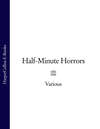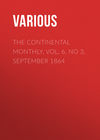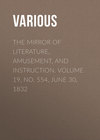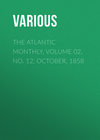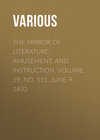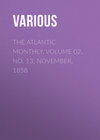Loe raamatut: «The Mirror of Literature, Amusement, and Instruction. Volume 13, No. 356, February 14, 1829», lehekülg 3
The Egyptian frigate, which had fired into our ship was distant about half a cable's length. Near her was another of the same large class, together with a Turkish frigate and a corvette. These four ships poured their broadsides into us without intermission for nearly a quarter of an hour; but after a few rounds their firing became irregular and hasty, and many of their shots injured our rigging. At the first broadside we received, two men near me were instantly struck dead on the deck. There was no appearance of any wounds upon them, but they never stirred a limb; and their bodies, after lying a little beside the gun at which they had been working, were dragged amid-ships. Several of the men were now severely wounded.
We were near enough to distinguish the Turkish and Egyptian sailors in the enemy's ships. They seemed to be a motley group. Most of them wore turbans of white, with a red cap below, small brown jackets, and very wide trousers; their legs were bare. They were active, brawny fellows, of a dark-brown complexion, and they crowded the Turkish ships, which accounts for the very great slaughter we occasioned among them. Many dead bodies were tumbled through their port-holes into the sea.
Capt. Hugon, commanding the French frigate L'Armide, about three o'clock, seeing the unequal, but unflinching combat we were maintaining, wormed his ship coolly and deliberately through the Turkish inner line, in such a gallant, masterly style, as never for one moment to obstruct the fire of our ship upon our opponents. He then anchored on our starboard-quarter, and fired a broadside into one of the Turkish frigates, thus relieving us of one of our foes, which, in about ten minutes, struck to the gallant Frenchman; who, on taking possession, in the most handsome manner, hoisted our flag along with his own, to show he had but completed the work we had begun. The skill, gallantry, and courtesy of the French captain, were the subject of much talk amongst us, and we were loud in his praise. We had still two of the frigates and the corvette to contend with, whilst the Armide was engaged, when a Russian line-of-battle-ship came up, and attracted the attention of another Egyptian frigate, and thus drew off her fire from us. Our men had now a breathing time, and they poured broadside upon broadside into the Egyptian frigate, which had been our first assailant. The rapidity and intensity of our concentrated fire soon told upon the vessel. Her guns were irregularly served, and many shots struck our rigging. Our round-shot, which were pointed to sink her, passed through her sides, and frequently tore up her decks in rebounding. In a short time she was compelled to haul down her colours, and ceased firing. We learned afterwards, that her decks were covered with nearly one hundred and fifty dead and wounded men, and the deck itself ripped up from the effects of our balls. In the interim, the corvette, which had annoyed us exceedingly during the action, came in for her share of our notice, and we managed to repay her in some style for the favours she had bestowed on us in the heat of the business. Orders were then issued for the men to cease firing for a few minutes, until the Rose had passed between our ship and the corvette, and had stationed herself in such a position as to annoy the latter in conjunction with us. Our firing was then renewed with redoubled fury, The men, during the pause, had leisure to quench their thirst from the tank which stood on the deck, and they appeared greatly refreshed—I may say, almost exhilarated, and to their work they merrily went again.
The double-banked Egyptian frigate, which had struck her colours to us, to our astonishment began, after having been silenced for some time, to open a smart fire on our ships, though she had no colours flying. The men were exceedingly exasperated at such treacherous conduct, and they poured into her two severe broadsides, which effectually silenced her, and at the moment we saw that a blue ensign was run up her mast, on which we ceased cannonading her, and she never fired another gun during the remainder of the action. It was a Greek pilot, pressed on board the Egyptian, who ran up the English ensign, to prevent our ship from firing again. He declared that our shot came into the frigate as thick and rapidly as a hail-storm, and so terrified the crew, that they all ran below. From the combined effects of our firing, and that of the Russian ship, the other Egyptian frigate hauled down her colours. The corvette, which was roughly handled by the Rose, was driven on shore, and there destroyed.
Before this, however, a Turkish fireship approached us, having seemingly no one on board. We fired into her, and in a few minutes she loudly exploded astern, without doing us any damage. The concussion was tremendous, shaking the ship through every beam. Another fireship came close to the Philomel which soon sunk her, and in the very act of going down she exploded.
A large ship near the Asia was now seen to be on fire; the blaze flamed up as high as the topmast, and soon became one vast sheet of fire; in that state she continued for a short time. The crew could be easily discerned gliding about across the light; and, after a horrible suspense, she blew up, with an explosion far louder and more stunning than the ships which had done so in our vicinity. The smoke and lurid flame ascended to a vast height in the air; beams, masts, and pieces of the hull, along with human figures in various distorted postures, were clearly distinguishable in the air.
It was now almost dark, and the action had ceased to be general throughout the lines; but blaze rose upon blaze, and explosion thundered upon explosion, in various parts of the bay. A pretty sharp cannonading had been kept up between the guns of the castle and the ships entering the bay, and that firing still continued. The smaller Turkish vessels, forming the second line, were now nearly silenced, and several exhibited signs of being on fire, from the thick light-coloured smoke that rose from their decks.
The action had nearly terminated by six o'clock, after a duration of four hours. Daylight had disappeared unperceived, owing to the dense smoke of the cannonading, which, from the cessation of the firing, now began to clear away, and showed us a clouded sky. The bay was illuminated in various quarters by the numerous burning ships, which rendered the sight one of the most sublime and magnificent that could be imagined.
MEMORABLE DAYS
VALENTINE'S DAY
Seynte Valentine. Of custome, yeere by yeere,
Men have an usaunce, in this regioun,
To loke and serche Cupide's kalendere,
And chose theyr choyse, by grete affeccioun;
Such as ben move with Cupide's mocioun,
Taking theyr choyse as theyr sorte doth falle;
But I love oon whyche excellith alle.
LYDGATE'S Poem of Queen Catherine, consort to Henry V., 1440
In some villages in Kent there is a singular custom observed on St. Valentine's day. The young maidens, from five or six to eighteen years of age, assemble in a crowd, and burn an uncouth effigy, which they denominate a "holly boy," and which they obtain from the boys; while in another part of the village the boys burn an equally ridiculous effigy, which they call an "ivy girl," and which they steal from the girls. The oldest inhabitants can give you no reason or account of this curious practice, though it is always a sport at this season.
Numerous are the sports and superstitions concerning the day in different parts of England. In some parts of Dorsetshire the young folks purchase wax candles, and let them remain lighted all night in the bedroom. I learned this from some old Dorsetshire friends of mine, who, however, could throw no further light upon the subject. In the same county, I was also informed it was in many places customary for the maids to hang up in the kitchen a bunch of such flowers as were then in season, neatly suspended by a true lover's knot of blue riband. These innocent doings are prevalent in other parts of England, and elsewhere.
Misson, a learned traveller, relates an amusing practice which was kept up in his time:—"On the eve of St. Valentine's day, the young folks in England and Scotland, by a very ancient custom, celebrated a little festival. An equal number of maids and bachelors assemble together; all write their true or some feigned name separately upon as many billets, which they rolled up, and drew by way of lots, the maids taking the men's billets, and the men the maids'; so that each of the young men lights upon a girl that he calls his Valentine, and each of the girls upon a young man which she calls her's. By this means each has two Valentines; but the man sticks faster to the Valentine that falls to him, than to the Valentine to whom he has fallen. Fortune having thus divided the company into so many couples, the Valentines give balls and treats to their fair mistresses, wear their billets several days upon their bosoms or sleeves, and this little sport often ends in love."
In Poor Robin's Almanack, 1676, the drawing of Valentines is thus alluded to:
"Now Andrew, Antho-
Ny, and William,
For Valentines draw
Prue, Kate, Jilian."
Gay makes mention of a method of choosing Valentines in his time, viz. that the lad's Valentine was the first lass he spied in the morning, who was not an inmate of the house; and the lass's Valentine was the first young man she met.
Also, it is a belief among certain playful damsels, that if they pin four bay leaves to the corners of the pillow, and the fifth in the middle, they are certain of dreaming of their lover.
Shakspeare bears witness to the custom of looking out of window for a Valentine, or desiring to be one, by making Ophelia sing:—
Good morrow! 'tis St. Valentine's day,
All in the morning betime,
And I a maid at your window.
To be your Valentine!
In London this day is ushered in by the thundering knock of the postman at the different doors, through whose hands some thousands of Valentines pass for many a fair maiden in the course of the day. Valentines are, however, getting very ridiculous, if we may go by the numerous doggrels that appear in the print-shops on this day. As an instance, I transmit the reader a copy of some lines appended to a Valentine sent me last year. Under the figure of a shoemaker, with a head thrice the size of his body, and his legs forming an oval, were the following rhymes:—
Do you think to be my Valentine?
Oh, no! you snob, you shan't be mine:
So big your ugly head has grown,
No wig will fit to seem your own
Go, find your equal if you can,
For I will ne'er have such a man;
Your fine bow legs and turned-in feet,
Make you a citizen complete."
The fair writer had here evidently ventured upon a pun; how far it has succeeded I will leave others to say. The lovely creature was, however, entirely ignorant of my calling; and whatever impression such a description would leave on the reader's mind, it made none on mine, though in the second verse I was certainly much pleased with the fair punster. I wish you saw the engraving!
W.H.H

The first page or frontispiece embellisment of the present Number of the MIRROR illustrates one of the most recent triumphs of art; and the above vignette is a fragment of the monastic splendour of the twelfth century. Truly this is the bathos of art. The plaster and paint of the Colosseum are scarcely dry, and half the work is in embryo; whilst Kirkstall is crumbling to dust, and reading us "sermons in stones:" we may well say,
"Look here, upon this picture, and on this."
Kirkstall Abbey is situated a short distance from Leeds, in the West Riding of Yorkshire. Its situation is one of the most picturesque that the children of romance can wish for, being in a beautiful vale, watered by the river Aire. It was of the Cistercian order, founded by Henry de Lacy in 1157, and valued at the dissolution at 329l. 2s. 11d. Its rents are now worth 10,253l. 6s. 8d. The gateway has been walled up, and converted into a farm-house. The abbot's palace was on the south; the roof of the aisle is entirely gone; places for six altars, three on each side the high altar, appear by distinct chapels, but to what saints dedicated is not easy, at this time, to discover. The length of the church, from east to west, was 224 feet; the transept, from north to south, 118 feet. The tower, built in the time of Henry VIII., remained entire till January 27, 1779, when three sides of it were blown down, and only the fourth remains. Part of an arched chamber, leading to the cemetery, and part of the dormitory, still remain. On the ceiling of a room in the gatehouse is inscribed,











